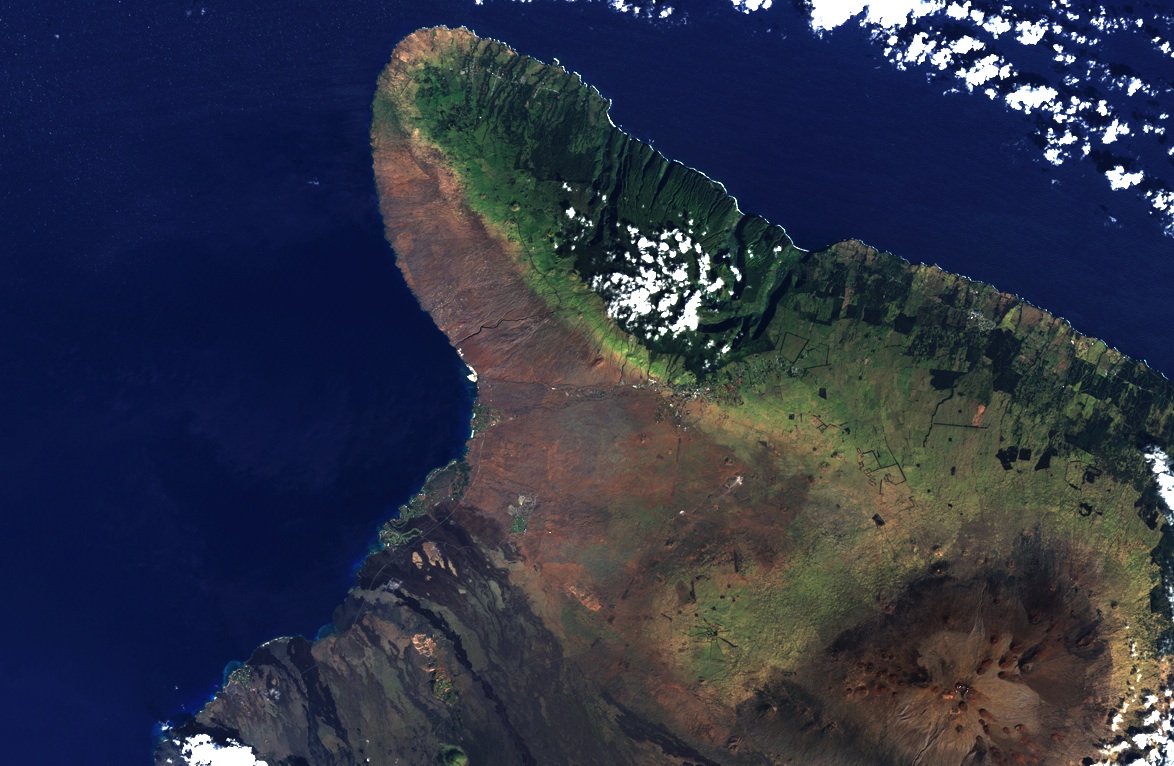What do Leeward and Windward Mean?
Special Stories
23 Jul 2018 7:40 AM
[A view from the leeward side: Kaena Point, Oahu, Hawaii. From NOAA]
An island’s windward side faces the prevailing, or trade, winds, whereas the island’s leeward side faces away from the wind, sheltered from prevailing winds by hills and mountains. As trade winds blow across the ocean, they pick up moist air from the water.
Known to sailors around the world, the trade winds and associated ocean currents helped early sailing ships from European and African ports make their journeys to the Americas. Likewise, the trade winds also drive sailing vessels from the Americas toward Asia. Even now, commercial ships use "the trades" and the currents the winds produce to hasten their oceanic voyages.
 [The Charles W. Morgan is the last of an American whaling fleet that once numbered more than 2,700 vessels. Ships like the Morganoften used routes defined by the trade winds to navigate the oceans.]
Once the damp air makes landfall on an island, it ascends hills and mountains to form condensation, clouds, and precipitation. As the air moves to the other side of the island, it warms up and dries out. Thus, an island’s windward side is wetter and more verdant than its drier leeward side. Meteorologists call this contrast the orographic effect.
[The Charles W. Morgan is the last of an American whaling fleet that once numbered more than 2,700 vessels. Ships like the Morganoften used routes defined by the trade winds to navigate the oceans.]
Once the damp air makes landfall on an island, it ascends hills and mountains to form condensation, clouds, and precipitation. As the air moves to the other side of the island, it warms up and dries out. Thus, an island’s windward side is wetter and more verdant than its drier leeward side. Meteorologists call this contrast the orographic effect.
 As an example, the Hawaiian Islands have damp windward sides and drier leeward sides most of the time as a result of the Pacific Ocean’s northeasterly trade winds. Windward locations are generally lush and green. Famously sunny beaches like Oahu’s Waikiki and Maui’s Wailea are found on the islands’ more sheltered leeward sides.
In sailing terminology, windward means "upwind," or the direction from which the wind is blowing. A windward vessel refers to one that is upwind of another vessel; a leeward vessel is downwind. In naval warfare during the Age of Sail, windward ships had the advantage due to much greater maneuverability than their leeward (downwind) foes.
Information from NOAA NOS
Edited for WeatherNation by Meteorologist Mace Michaels
As an example, the Hawaiian Islands have damp windward sides and drier leeward sides most of the time as a result of the Pacific Ocean’s northeasterly trade winds. Windward locations are generally lush and green. Famously sunny beaches like Oahu’s Waikiki and Maui’s Wailea are found on the islands’ more sheltered leeward sides.
In sailing terminology, windward means "upwind," or the direction from which the wind is blowing. A windward vessel refers to one that is upwind of another vessel; a leeward vessel is downwind. In naval warfare during the Age of Sail, windward ships had the advantage due to much greater maneuverability than their leeward (downwind) foes.
Information from NOAA NOS
Edited for WeatherNation by Meteorologist Mace Michaels
 [The Charles W. Morgan is the last of an American whaling fleet that once numbered more than 2,700 vessels. Ships like the Morganoften used routes defined by the trade winds to navigate the oceans.]
Once the damp air makes landfall on an island, it ascends hills and mountains to form condensation, clouds, and precipitation. As the air moves to the other side of the island, it warms up and dries out. Thus, an island’s windward side is wetter and more verdant than its drier leeward side. Meteorologists call this contrast the orographic effect.
[The Charles W. Morgan is the last of an American whaling fleet that once numbered more than 2,700 vessels. Ships like the Morganoften used routes defined by the trade winds to navigate the oceans.]
Once the damp air makes landfall on an island, it ascends hills and mountains to form condensation, clouds, and precipitation. As the air moves to the other side of the island, it warms up and dries out. Thus, an island’s windward side is wetter and more verdant than its drier leeward side. Meteorologists call this contrast the orographic effect.
 As an example, the Hawaiian Islands have damp windward sides and drier leeward sides most of the time as a result of the Pacific Ocean’s northeasterly trade winds. Windward locations are generally lush and green. Famously sunny beaches like Oahu’s Waikiki and Maui’s Wailea are found on the islands’ more sheltered leeward sides.
In sailing terminology, windward means "upwind," or the direction from which the wind is blowing. A windward vessel refers to one that is upwind of another vessel; a leeward vessel is downwind. In naval warfare during the Age of Sail, windward ships had the advantage due to much greater maneuverability than their leeward (downwind) foes.
Information from NOAA NOS
Edited for WeatherNation by Meteorologist Mace Michaels
As an example, the Hawaiian Islands have damp windward sides and drier leeward sides most of the time as a result of the Pacific Ocean’s northeasterly trade winds. Windward locations are generally lush and green. Famously sunny beaches like Oahu’s Waikiki and Maui’s Wailea are found on the islands’ more sheltered leeward sides.
In sailing terminology, windward means "upwind," or the direction from which the wind is blowing. A windward vessel refers to one that is upwind of another vessel; a leeward vessel is downwind. In naval warfare during the Age of Sail, windward ships had the advantage due to much greater maneuverability than their leeward (downwind) foes.
Information from NOAA NOS
Edited for WeatherNation by Meteorologist Mace MichaelsAll Weather News
More